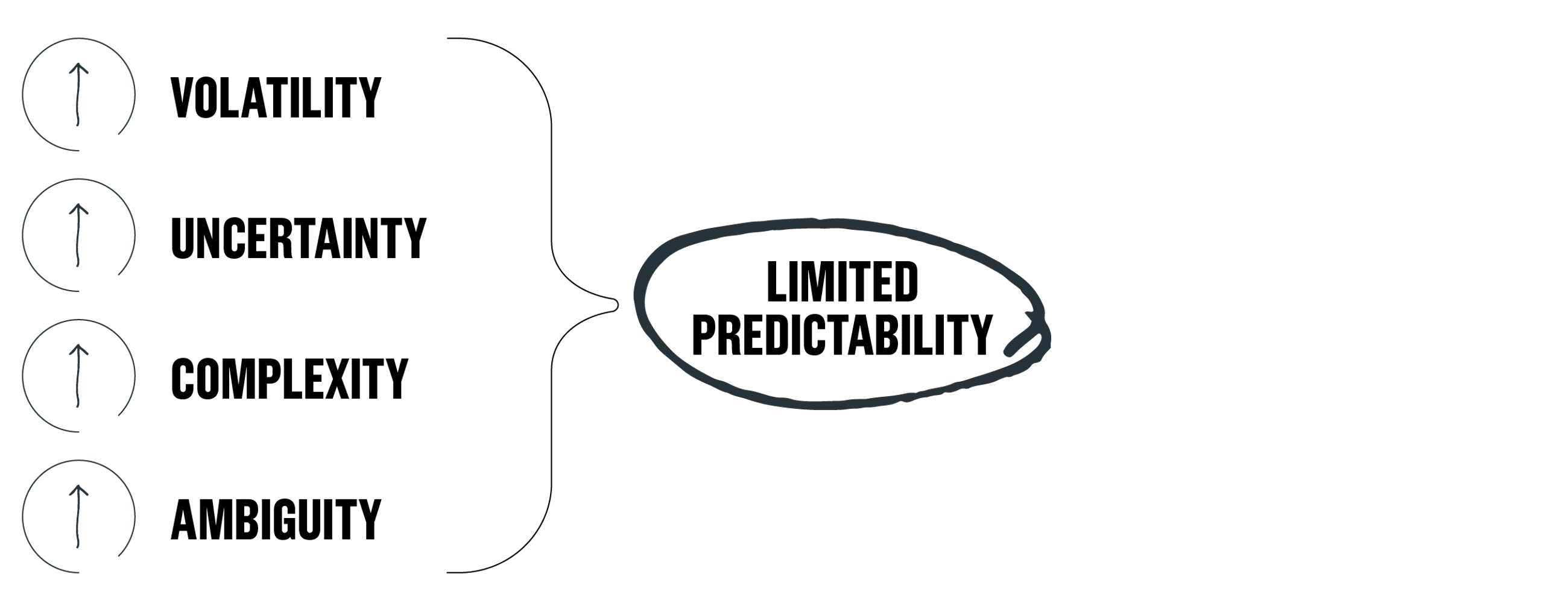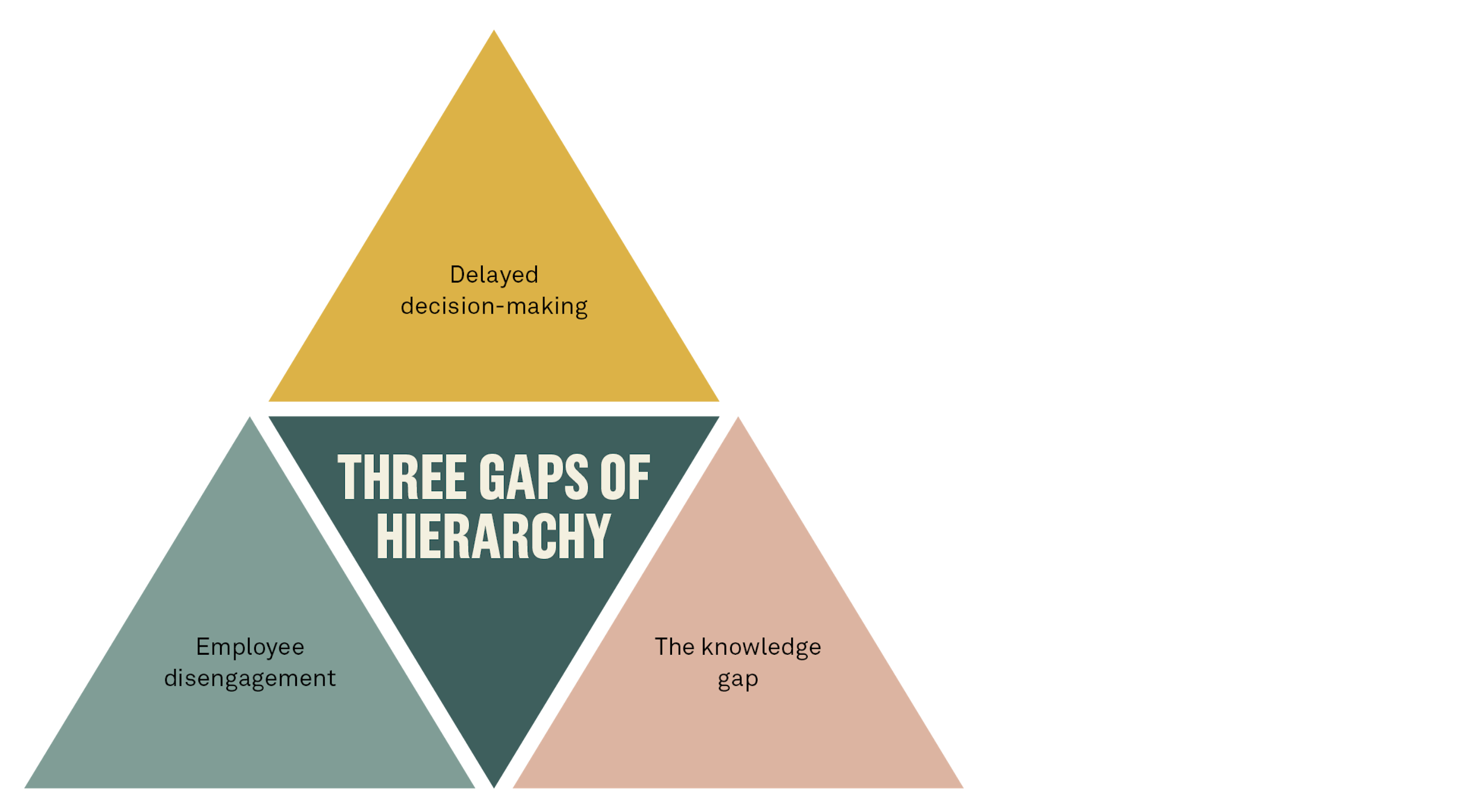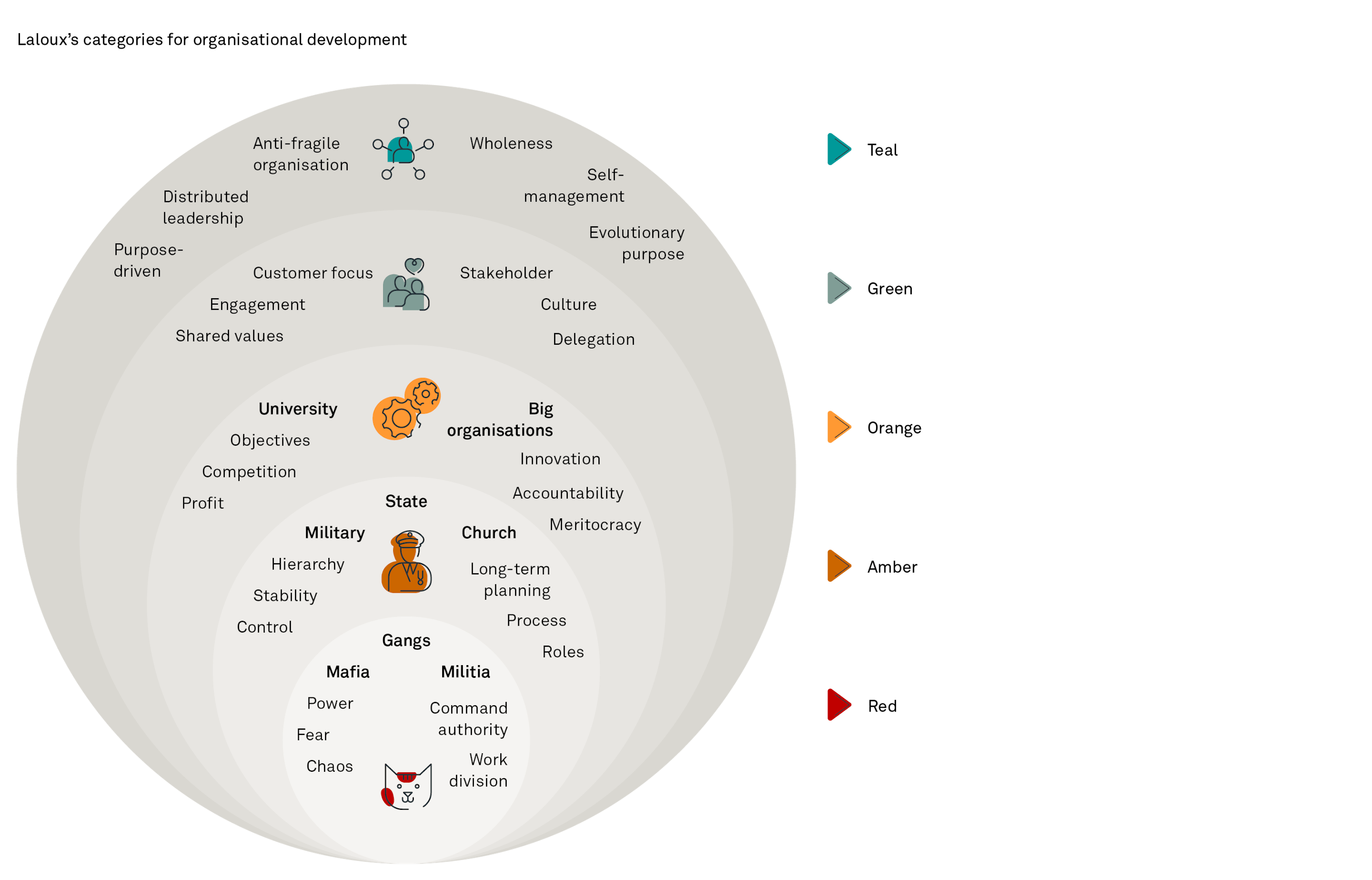– and start enabling human contribution
27 May 2021
If you are a manager of a team of 14 employees, there is on average only one single person of your entire team who considers himself or herself to be fully engaged in the job*. Hierarchical organisational structures are (partially) to blame for low levels of engagement, as they aim to maximise efficiency instead of maximising human contribution to create impact. Yet you can change this by questioning some of our fundamental assumptions about running organisations. Here is our view on the benefits of human-centric organisations and three steps for how you can make a change.
Do you work in an organisation that is still hierarchically organised, hoping to effectively address arising challenges despite limited predictability surrounding your business environment? And does your organisation also struggle to respond to external changes in a timely and effective manner? Then you are not alone!
The hierarchical organisational setup and its underlying assumptions regarding strategy-making, decision-making and employee motivation seem to fall short to effectively respond to changes in today’s highly unpredictable world. A new way of organising in a non-hierarchical manner has therefore become a hot topic across small and large organisations all around the world. Organisations such as Buurtzorg (the Netherlands), Morning Star (USA) and Haier (China) showcase how to outperform competitors by radically changing your organisational setup and operating model and thereby fundamentally challenging existing assumptions about your workforce, productivity and strategy-making.
Engaging in a world with limited predictability
The world around us has become more volatile, more uncertain, more complex and ambiguous than it ever has been. With an increasing speed of changing surroundings, newly emerging informal and formal power structures and communication through a variety of informal and formal channels, the level of predictability has come to an all-time low.
Nevertheless, many organisations are still working with long-term strategies as well as top-down and centralised decision power. Yet our ability to predict changes – and the extent to which we can predict the potential effects – is only insufficiently captured by a 5-year strategy and hierarchical decision-making processes, which can take weeks and even months to escalate.
Shortcomings of hierarchical organisations to handle limited predictability
We see three typical phenomena that hierarchically organised companies are challenged by when operating in environments with low levels of predictability: delayed decision-making, knowledge gap and employee disengagement.
- Delayed decision-making captures the delay of hierarchically organised firms due to their centralised, top-down decision-making process. With the decision-making mandate being at the top of the organisation, the escalation of information is time-consuming, and organisations often fail to act on emerging opportunities with adequate speed.
- The knowledge gap describes the mismatch between deep functional insights existing at the bottom of the organisation; however, decisions are taken based on consolidated, abstract insights at the top of the organisation. The “lower levels” of the organisation are often much closer to the customers and sourcing partners and therefore better understand the respective needs, potential risks and arising opportunities. However, employees at the lower levels of the organisation often cannot take immediate action on their insights but are expected to consolidate their insights and escalate them up in the organisation, where the decision is then taken at a distance. And this phenomenon also leads to the third challenge: low levels of employee engagement.
- Employee disengagement describes the effects of employees’ detachment from decision-making despite having the deepest insights. Feeling left out on important decisions despite having the deepest functional insights left employees with limited motivation to seek and pursue new opportunities in the long run. Only 14% of employees feel that they are fully engaged in their jobs*.
To overcome these three phenomena and to be able to adequately prepare for limited predictability, your organisational setup must increasingly distribute knowledge and decentralise decision-making power. To do that, your organisation has to re-define leadership, existing processes, organisational structures and lastly coach and trust their employees to take on more responsibility to be able to react to the ever-changing surroundings quickly and effectively.
If you decide to give your employees more responsibility, you will also need to give them autonomy to take decisions themselves. Delegating decision-making power without giving autonomy will ultimately lead to a blockade in your business. However, if you give your employees both decision-making power and the autonomy to take decisions themselves (including access to relevant information), you will ultimately end up with a highly motivated and responsible workforce constantly exploring new opportunities for impact creation.
Creating higher levels of impact by building a motivated workforce
Running a company where employees are motivated and engaged is not just a nice story to tell. Data shows that it also creates impact on your organisation’s bottom line. Gallup’s State of the Global Workplace report (2018) has shown that organisations with highly motivated employees have 21% higher profitability, 20% higher sales and 17% higher levels of productivity. High levels of motivation are typically observed for employees who are driven by a broader purpose and have the functional expertise and autonomy to take relevant decisions in their work life (Daniel Pink, 2009). To increase your employees’ level of engagement, your employees need to have a clear decision-making mandate for their field of expertise paired with full access to relevant information to make fact-based decisions.
Building a humanocratic organisation to explore opportunities in an ever-changing environment
There is an underlying shift of perspective to this way of running an organisation, which Gary Hamel and Michele Zanini, the authors of the book “Humanocracy” (2020), nicely point to. They argue that organisations that want to be fit for the future need to “put human beings, not structures or processes, at the centre of our organisations. Instead of a management model that seeks to maximise control for the sake of efficiency, we need one that seeks to maximise contribution for the sake of impact. In short, we need to replace bureaucracy with humanocracy” (Michele Zanini, 2020. Watch on YouTube). So instead of considering human beings as an input factor to delivering products or services and constantly aiming to get employees to serve the organisation in an even more effective manner, the humanocratic organisation considers the organisation as an instrument and instead aims to make the organisational setup fit to bring forward the best of what employees can contribute with.
Focusing on humans as the most central part of impact creation also ultimately requires – and enforces – higher levels of engagement of your employees. Sounds promising? But what does it take to reinvent your organisation to make work productive, fulfilling and meaningful?
Embarking on the journey towards a more humanocratic organisation
Your ambition and reasoning to become a more humanocratic organisation can vary from your competitors, and there is no “one right path” to go about this. However, there are three steps to follow if you want to transform your organisation into a more humanocratic one.
Step 1: Assess the underlying assumptions to your operating model right now
Start by assessing where on the continuum between bureaucracy and humanocracy your organisation stands right now. Laloux (2014) divides organisations into five maturity levels, which evolve in terms of human centricity. Examples range from mafia-like organisations (red), scoring high on power, fear and command of authority, to teal organisations, which are characterised by e.g. having an evolutionary purpose, using self-management and having distributed leadership. Start by assessing where your organisation stands right now.
Step 2: Be clear on your ambition and your reason for becoming more human-centric
If you want to transform your organisation from where it is right now into a more human-centric one, then you should be very clear on your “why”. Why is it that you want to change? How much do you want to change? Is your ambition to become a teal organisation, or does an orange organisational setup serve your purposes best? Become clear and formalised about which goals you aim to achieve by evolving your organisations.
Step 3: Define the central steps by involving your organisation from the beginning
Involve your organisation broadly and from the very beginning when planning the central steps to change. Special attention should be given to the following elements: which kind of leadership style encourages more self-managed employees? How do you need to adjust your organisation’s strategy, KPIs and team structures to decentralise decision-making power and autonomy? Invite your entire organisation to find answers to these questions collectively. It will be a shared responsibility for every employee to change the fundamental assumptions on how to run your organisation in a more humanocratic manner going forward.
Sources
*Hayes, M., Chumney, F. & Buckingham, M. (2020). Global Workplace Study 2020, 29 September 2020, ADP Research Institute.
Pink, D. (2009). Drive: The Surprising Truth About What Motivates Us.
Zanini, M. (2020). What is Humanocracy?
Laloux, F. (2014). Reinventing organizations.
Gallup (2018). Gallup’s State of the Global Workplace report.







